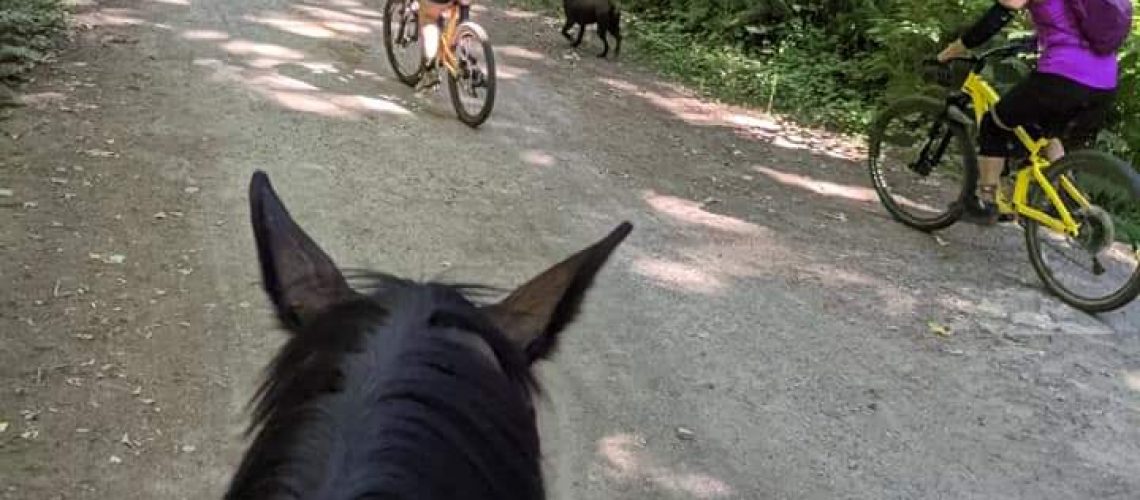When I was a young rider going through training with the British Horse Society, one of the things I was exposed to was a proper “legging up” program for a horse. At the time, it was common for horses to be turned out in pasture for the summer and then brought back to work for the fox hunting season through the winter. At the same time, I was reading articles by US Olympic 3-Day Eventer, Denny Emmerson. He wrote extensively about “body building” for your horse. What stuck with me was the slow, careful, and progressive approach that was a commonality between the two sources.
These weren’t 4 week programs that resulted in a horse that could trot and canter over distance without falling down exhausted. These were programs for the life of the horse. They included thought of how the horse’s skin would have to adapt to the rubbing of the tack again after a long layoff, and how the tendons and ligaments would have to be conditioned to support the added activity under the rider’s weight, and how varying footing and terrain would improve the horse’s overall condition. And, above all, the concept that taking the time to do long and slow conditioning would do more for the horse’s long term fitness and soundness than fast and aggressive training ever would.
Since those early educational influences, I have rehabilitated numerous horses for everything from ligament injuries to back injuries, and even age related physical challenges like backs dropping. The approach and techniques I’ve used most successfully have drawn heavily on that long and slow concept. Here are some of the key components to a truly successful conditioning program, as I have experienced it:
- Maximize turnout as much as is humanly possible. I’ve been at stables where horses are lucky if they get turned out for one hour a day in a small gravel paddock, and I’ve been at stables where the horses are turned out all day (or night) in large fields. The ones that are out the most have the strongest, most injury resistant bodies. The ones that navigate hills during their turnout have an even greater advantage.
- Never underestimate the value of walking. Denny Emmerson talks about how important it is to build on a solid fitness base when it comes to conditioning horses for sport, and much of that is established in the walk. Walk is like the Pilates of training. It’s deliberate, it’s low impact, it’s got a significantly reduced risk for injury – even if it’s over done, and it can be done safely in nearly any sort of footing or over any sort of terrain. It’s also safer for riders who aren’t quite as fit or balanced as they could be. It’s also the best recovery gait for interval training.
- Vary your routine as much as possible. Even Carl Hester, British Olympic Gold Medalist says that even his top international horses don’t work in the arena more than 4 days each week. In between they hack out or do some sort of cross training. In my program, I incorporate every possible thing I can think of to vary the horse’s routine. That includes working up and down hills (walking only for a long time), interval training (trotting or cantering for short intervals with recovery walk intervals between each trot or canter set), cavaletti training, long-reining work without a rider, hacking through the woods or on the road (road conditioning can be quite good for the horses’ legs, especially if you stay in walk), and even free jumping.
- Be patient, take time and don’t rush. I’ve always maintained that I have never regretted going slower than necessary when conditioning a horse, but I have always regretted going too fast. Muscles take time to strengthen while tendons and ligaments take even more time to support increased demands on a horse’s joints. If you have a time goal for a specific level of fitness, count backwards from that date and make sure you begin with plenty of time to slowly increase your horse’s workload to reach that fitness goal.
- If you work a horse twice a day, you can do each session for half the time and get greater benefits than if you do a longer workout only once a day. Horses being creatures of movement thrive on more movement rather than less. Additionally, assuming you stick to the wide variety concept, shorter work periods mean your horse is less likely to get fatigued with each session. This means less recovery time needed, less chance of repetitive strain injuries, and overall quicker results.
- Strive for your horse’s relaxation in all the work you do. Muscles and joints that are worked in relaxation become stronger and more resilient than those worked through tension, so make relaxation your priority. If your program is heavy on the walking, this will be easier than if you’re always trying to do a “training” ride.
- Increase workload by small increments over time. The standard increment used in rehabilitating horses from soft tissue injuries is 5 minutes per week for trot and about 2.5 minutes per week of canter. A good measure for your horse’s level of fitness is this: if your horse is breathing hard and it takes him or her more than 2 minutes to take a deep recovery breath, then he or she is not fit enough for the intensity of the work you are doing. Pay attention to little things like that so you aren’t risking injuring your horse because you didn’t realize you were pushing too hard.
- Keep your horse as comfortable as possible. If you’ve ever started a new fitness program with a personal trainer or at a gym, you *know* how much sore muscles hurt. The same is no less true for your horse. Assuming you aren’t going to be going to a competition within the legal window of 7 days, don’t be afraid to give your horse a gram of Bute after a particularly hard workout. Liniment rubs feel good. If you think your horse’s legs might be fatigued, occasionally lightly wrapping them overnight (assuming your horse is stalled overnight) can help support the tendons and ligaments, reducing some of the strain of standing around for long periods. Occasional massages can help fatigued muscles recover faster or tight muscles release and work more efficiently. Periodic chiropractic and acupuncture can keep your horse tuned up and functioning at optimum capability, so that your conditioning program is as effective as possible.
My veterinarian once said “The hardest part of doing any sport at a high level is actually getting to that level.” In other words, once the horse is conditioned to a point, maintaining that level of fitness is easier on their bodies than the actual process it takes to get there the first time. The horse’s body must adapt constantly to new challenges and because they can’t tell us how they feel, at every step along the way there is a risk of each added stress being just a little too much. So take your time, give your horse every possible support that you have the resources for, and your horse will thrive in its conditioning program.

